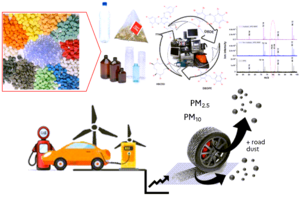1) Environmental Science and Energy Transition
The physical properties, chemical reactions, evolution, and characterization of either particles or molecules involved in atmospheric processes are tackled from a physico-chemical perspective using commercial or home-built instrumentation. Research activities of interest to the understanding of heterogeneous processes occurring in the condensed–phase and at the solid-gas interface address aerosol surfaces’ composition and nanostructure and mechanisms by which efficient atmospheric ice nucleators act and their activity. The energy transition theme is addressed through the lens of the gas hydrate technology. Investigations regarding the formation conditions of gas hydrates in natural environments, and their potential applications in an industrial context are carried out by the team.
Funding: ANR SOFORA, ANR EffPhoB, ANR Mi2C, ANR UNREAL, H2020 PEMs4Nano, INTERREG2SEAS C2V, CPER CLIMIBIO, CPER ECRIN, CPER WaveTech@HdF, Labex CaPPA, Industries du Futur Raman 4.0, CDP AREA
• Aerosols: formation, fate in the atmosphere, and health impacts

Aerosols are a crucial element at the heart of the Earth-atmosphere system, and understanding their behavior and impacts is essential to developing effective policies to mitigate climate change and improve air quality. ANATRAC plans to continue on engaging its solid expertise in surface science and aerosols characterization using laser-assisted mass spectrometry and vibrational techniques to address the challenges of contemporary transitions. ANATRAC objectives are to provide in-depth characterizations about the chemical composition and nanostructure of native carbon-bearing aerosols, reveal their molecular transformations upon atmospheric processing and aging, identifying the reciprocal effects induced by these chemistries, and unveil their change when processed by human cells. Recent collaborations highlighted the great potential of our developed instrumentation and its detection capabilities to assess the migration and transformation of harmful organics in cell tissues.
• Particles emissions: monitoring environmental quality in the current energy, transport, and mobility transitions

Initiated with the investigations of soot particles emitted from internal-combustion engines (ICE), ANATRAC plans to apply and expand the comprehensive surface multi-technique analytical protocol recently implemented to the analysis of particles of growing interest in the transitions of the transport sector and mobility systems and in the quest of limiting plastic pollution. ANATRAC was part of a European network that proposed cutting edge (imaging) analytical techniques to get a better understanding of the array of health impacts posed by small plastic particles entering the human body, with ta focus on the most common contaminants: tire particles and PET particles/fibers.
• Gas hydrates: smart solutions for carbon capture, water desalination and energy storage
Gas separation and capture: this theme will evolve towards the treatment of natural and industrial gases, with a special focus on the synergistic effect of gas hydrates and nano-porous materials to improve kinetics and gas storage capacity. Water desalination: Our aim will be to investigate hydrate formation process at specific conditions to optimize performance parameters to help advancing the water desalination knowledge base. Energy storage: The intermittent production and load leveling of renewable energies highlighted the need to develop new efficient energy storage solutions. The storage ensures that energy can be spared during low-demand hours, and later supplied to the grid based on peak demand, or as a buffer in the event of a failure of a local electricity distribution service. ANATRAC will investigate the performances of an energy storage system (gas hydrates) using hydrogen as a vector.

